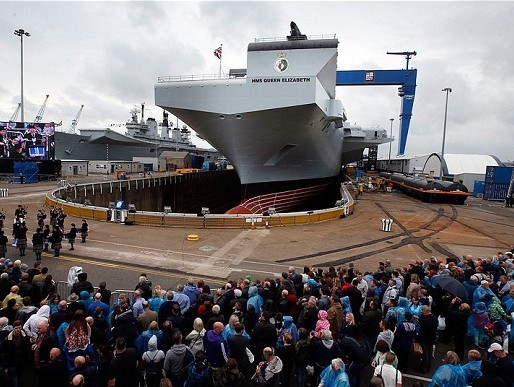The 65,000-ton Royal Navy aircraft carrier Queen Elizabeth, launched by Her Majesty on July 4 and praised as “a national instrument of power,” is in fact “a ship with no real purpose other than to act as the monument to yet another failed dream of EU integration,” according to historian and journalist Christopher Booker.
The £6.2bn ship, the largest in the Royal Navy, is scarcely a “moment for pride” that we should leave our once truly proud Royal Navy equipped with little more than “HMS White Elephant,” Booker writes today in the Sunday Telegraph.
Even before the launch, there were questions raised over the ship’s purpose. No aircraft will be able to fly off it until 2020. Despite a vast flight deck, it is not designed to handle fixed-wing aircraft, only the American-built vertical take-off F35, which is still in development with chronic design problems.
The first international appearance of the aircraft was due in Britain earlier this month at the Royal International Air Tattoo, but it was cancelled because the plane remains grounded in the US.
The F-35 seen on board the ship at the launch was in fact a fibre glass replica, a plastic kit plane defence giant Lockheed Martin assembles for air shows and exhibitions.
Other questions have been raised that HMS Queen Elizabeth should be nuclear powered like American aircraft carriers, not by diesel and gas. More, the Royal Navy no longer has enough surface craft to provide escort for an aircraft carrier.
According to Booker, this “monster ship” is like that proverbial camel – “a horse designed by a committee.”
He says the real question is what purpose is the ship meant to serve? “Why was a ship almost as large as the rest of the Navy put together wanted in the first place?”
Booker tracks the real story back to 1996, when Britain and other EU member states were discussing ways to integrate the EU’s defence efforts.
The then-defence secretary, Michael Portillo, signed a Letter of Intent with his French counterpart setting up 23 Anglo-French naval study groups, including one on “Future aircraft carrier development.”
Booker says: “In 1998 this led to the St-Malo agreement between Tony Blair and President Chirac to work on a new integrated EU defence force. This led in turn to the 1999 ‘Helsinki goals,’ centred on setting up a European ‘Rapid Reaction Force’ able to operate anywhere in the world.”
This EU force was to include three giant aircraft carriers, two built by Britain, one by France, “with other navies such as those of Spain and Italy providing the necessary escort cover.”
Fifteen years and a rolling eurozone crisis later, talk of an EU Rapid Reaction Force has faded, but Britain has been left supplying her part of the deal, a monster aircraft carrier – the plans for a second British aircraft carrier have been abandoned — “with no real purpose other than to act as the monument to yet another failed dream of EU integration.”

COMMENTS
Please let us know if you're having issues with commenting.